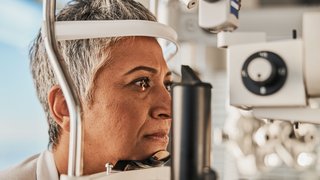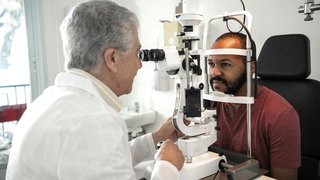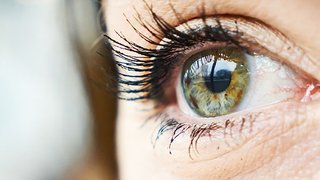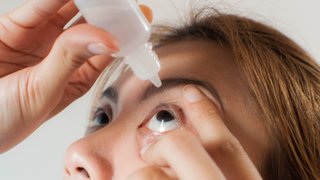Diabetic Eye Disease: Spotting Early Signs and Symptoms
April 9, 2025

About 30.3 million adults in the U.S. have diabetes, according to the Centers for Disease Control (CDC), and 90% of them have Type 2 diabetes – their bodies don't handle insulin well and can't maintain normal blood sugar levels.
What's more, as many as one in four working-age adults (those in their early 20s to early 60s) have Type 2 diabetes, but they don't know it. So, you can imagine their surprise when they see me, an ophthalmologist, for blurred vision or eye floaters, and we hand them a referral to get checked for diabetes.
Risks Factors for Diabetic Eye Disease
Patients with Type 2 diabetes are at increased risk for diabetic eye disease, a group of diabetes-related eye conditions such as diabetic retinopathy and diabetic macular edema (DME). Approximately one third of my working-age patients have diabetic eye damage, and diabetic retinopathy is the leading cause of blindness in this age group.
Related reading: Protecting teens and young adults from type 2 diabetes
Left untreated, diabetic eye diseases can cause permanent vision damage and even blindness, so it’s imperative to catch the signs early on to have the best treatment outcome.
to do that, it's important to know the symptoms – even if you haven't been diagnosed with diabetes.
Diabetic Retinopathy Symptoms

Diabetic retinopathy causes blood vessel damage in the retina. Left untreated, it can cause vision loss and can develop into DME.
Approximately 40% to 45% of patients with diabetes have symptoms of diabetic retinopathy, though many don't notice it. Symptoms can include:
- Blurry vision
- Floaters (white or translucent visual blockers that come and go)
- Faded, washed out appearance of colors
- Blank or dark areas in your field of vision
Diabetic Macular Edema Symptoms
Diabetic macular edema is a build-up of fluid in the center of the retina, or the macula. This part of the eye is responsible for sharp vision and most of our color vision. Symptoms can include:
- Blurry or wavy vision in the center of your field of vision
- Floaters
- Noticing colors appear faded or washed out
Diagnosing Diabetic Eye Disease
Both forms of diabetic eye disease, diabetic retinopathy and diabetic macular edema, are treatable. Types of treatment and effectiveness depend on the severity of the condition, so it’s important to catch signs of the disease as early as possible.
At UT Southwestern, we take a multidisciplinary approach to diagnose and treat diabetic eye disease. If we detect diabetes-related eye symptoms and you have been diagnosed with diabetes, we can recommend that you follow up with your endocrinologist or primary care doctor.
If we see signs of eye disease but you have not been diagnosed with diabetes, we can refer you to a diabetes expert at UT Southwestern. The ophthalmology team works closely with our endocrinology doctors and nurses to make sure you have the treatment and information you need to reduce your risks.
Treatment Options for Diabetic Eye Disease
Your provider will work with you to develop an optimal treatment plan. Two of the most common strategies to manage diabetic eye disease include controlling your diabetes and medical management through medication and surgery.
Controlling Your Diabetes
We typically recommend three key steps to controlling your diabetes:
- Make healthy lifestyle choices. Low-intensity physical activity, such as walking or doing yoga, should be part of your daily routine. Prioritize eating a healthier diet that includes more fiber, such as beans, fruits, vegetables, nuts, and whole grains and fewer carbohydrates.
- Watch blood sugar levels. Check with your doctor how often to monitor and record your sugars. Testing your A1C levels (the percentage of blood sugar attached to a certain protein that oxygenates the blood) regularly can help you stay on track.
- Take medications as prescribed. Sometimes blood pressure or cholesterol medication can affect your blood sugars. It's important to take these medications as prescribed and to work with your doctor to adjust dosages if your sugar rises too high.
Eye medication

During regular office visits, your ophthalmologist can administer medications directly into the eye. Anti-vascular endothelial growth factor (anti-VEGF) therapy is a commonly used medication treatment to reduce retinal swelling and inhibit blood vessel growth in the retina.
Another option is corticosteroid medication, which can reduce inflammation caused by diabetic retinopathy.
Eye surgery
For some patients, minimally invasive surgery can help slow progression of diabetic eye disease. Common surgeries include:
- Laser procedures, which can shrink or seal off blood vessels to decrease swelling.
- Vitrectomy, which is a procedure to remove vitreous eye fluid and blood that can leak from blood vessels. The ophthalmologist can replace the gel-like vitreous fluid with saline or another sterile substance to treat eye floaters and other diabetes-related symptoms.
Managing Diabetic Eye Disease Symptoms
When managing diabetic eye disease, it’s important to take action before the symptoms begin to control your vision. Even if you haven't been diagnosed with Type 2 diabetes, don’t forgo an eye exam if you experience vision issues. Working-age adults can greatly reduce their risk for diabetic eye disease with preventative care.
To find out whether you or a loved one might benefit from a check-up with an ophthalmologist, call 214-645-8300 or request an appointment online.
Dr. Yu-Huang He realizes his vision for care
Dr. Yu-Huang He grew up in China during the Cultural Revolution, working on rice farms and seeing firsthand the substandard medical conditions for workers. That experience inspired him to become a doctor, and while in medical school he was drawn to the complexities of the eye. As an ophthalmologist at UT Southwestern he has developed lifelong relationships with patients with eye conditions.











